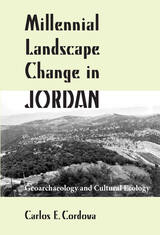2 books about Cultural Ecology

Millennial Landscape Change in Jordan
Geoarchaeology and Cultural Ecology
Carlos E. Cordova
University of Arizona Press, 2007
Stands of relict vegetation, soil horizons, and sedimentary deposits along with archaeological evidence suggest that during certain time spans within the past twenty millennia, Jordan was endowed with moister and more vegetated landscapes than the ones we see today. In this detailed volume, Carlos E. Cordova synthesizes diverse information on multiple topics to provide a comprehensive view of the changes in the Jordanian landscape and the many ways it has been affected by human habitation and the forces of nature.
Cordova focuses on geoarchaeological and cultural ecological aspects of research, presenting data from physical, chemical, and biological sources. He examines the changing influence of climate, vegetation, and hunting opportunities on cultural exploitation tactics, as well as the effects of the growing population and agriculture on the environment. Cordova argues that an interdisciplinary approach to studying the area is crucial to achieving a true understanding of Jordan’s changing landscape.
Chapter topics include approaches to the study of ancient Jordanian landscapes in the Near Eastern context; the physical scene; endowed landscapes of the woodlands; the encroaching drylands; the current and future state of the paleoecological and geoarchaeological record; patterns of millennial landscape change; and the process of interpreting millennial landscape change. The text is abundantly illustrated with photos, line illustrations, tables, and maps, providing a valuable assessment of archaeological developments over the prehistory and history of what today is the Hashemite Kingdom of Jordan. This volume will be especially welcomed by scholars interested in the archaeology, history, and geography of Jordan, the Levant, and the Near East and by field-school students working on archaeological projects in Jordan.
Cordova focuses on geoarchaeological and cultural ecological aspects of research, presenting data from physical, chemical, and biological sources. He examines the changing influence of climate, vegetation, and hunting opportunities on cultural exploitation tactics, as well as the effects of the growing population and agriculture on the environment. Cordova argues that an interdisciplinary approach to studying the area is crucial to achieving a true understanding of Jordan’s changing landscape.
Chapter topics include approaches to the study of ancient Jordanian landscapes in the Near Eastern context; the physical scene; endowed landscapes of the woodlands; the encroaching drylands; the current and future state of the paleoecological and geoarchaeological record; patterns of millennial landscape change; and the process of interpreting millennial landscape change. The text is abundantly illustrated with photos, line illustrations, tables, and maps, providing a valuable assessment of archaeological developments over the prehistory and history of what today is the Hashemite Kingdom of Jordan. This volume will be especially welcomed by scholars interested in the archaeology, history, and geography of Jordan, the Levant, and the Near East and by field-school students working on archaeological projects in Jordan.
[more]

The Toda Landscape
Explorations in Cultural Ecology
Tarun Chhabra
Harvard University Press
The Todas are the oldest inhabitants of the Nilgiri Hills of South India. With their quaint barrel-vaulted architecture, embroidered cloaks, and long-horned buffaloes, they have fascinated the world ever since civilization stepped into the Nilgiris two centuries ago. Their culture revolves around these herds, with each of the six grades of dairy-temple having its corresponding herd of sacred buffaloes. A Toda prayer consists of chant words addressed to sacred natural landmarks such as nearby peaks, slopes, thickets, trees, rocks, meadows, pools, and streams. The Todas represent a rare example of an indigenous culture that has remained generally vegetarian. The Prologue highlights the journey that led to Tarun Chhabra’s being accepted as an “insider.” The thirteen chapters provide detailed ethnographic descriptions of sacred dairy-temple institutions; the Toda relationship with honey; the intricacies of their attire and embroidery motifs; details related to seasonal migrations; settlement patterns; sacred geography and traditional architecture; a spirit’s journey to the afterworld; and ethnobotany. The four appendices focus on the Toda relationship with their flora and fauna, lists of landscape terms, and the all-important prayers for major hamlets. The book includes significant new data and represents a major breakthrough in Toda studies.
[more]
READERS
Browse our collection.
PUBLISHERS
See BiblioVault's publisher services.
STUDENT SERVICES
Files for college accessibility offices.
UChicago Accessibility Resources
home | accessibility | search | about | contact us
BiblioVault ® 2001 - 2024
The University of Chicago Press









